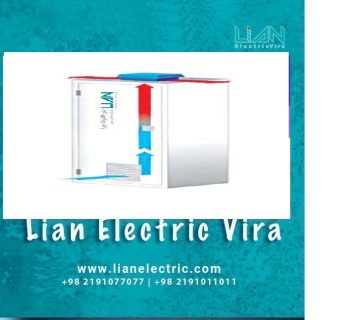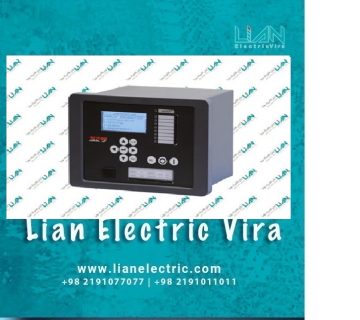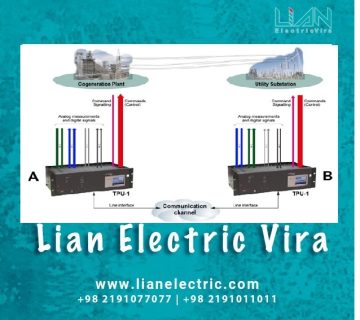کدهای حفاظتی مختلف در رله های حفاظتی
رله های حفاظتی یکی از مهم ترین بخش های یکی سیستم قدرت می باشند. در صورت بروز خطا، به علت مقاوت پایین محل خطا، جریان بسیار زیادی از آن عبور خواهد کرد. در حالت کارکرد عادی شبکه عبور این جریان بالا غیر مجاز است ولی متاسفانه رخداد خطا سبب این امر می شود. به منظور حفاظت از تجهیزات گران قیمت به کار رفته، ایمنی و حفاظت از جان افراد و پرسنل، و هم چنین جلوگیری از گسترش خطا و ایجاد خاموشی های گسترده، استفاده از رله حفاظتی امری اجتناب ناپذیر می باشد. (استفاده از رله های حفاظتی برای حفاظت از خطوط انتقال)
رله حفاظتی انواع مختلفی دارد و می تواند از سیستم در برابر رخدادهای گوناگون مانند عبور جریان زیاد، ایجاد شدن گرمای زیاد، اضافه بار، نامتعادل شدن ولتاژ و … محافظت کند. رایج ترین نوع رله حفاظتی از سیستم در برابر عبور جریان زیاد محافظت می کند. دلیل استفاده بسیار زیاد از این نوع رله ها، خطرناک بودن عبور جریان زیاد از سیستم می باشد. همانطور که مشخص است جریان زیاد به همراه خود گرمای زیادی تولید می کند که سبب آتش سوزی خواهد شد. از دیگر انواع رله حفاظتی نیز در سیتسم به منظور کاربردهای متفاوت استفاده خواهد شد. (تفاوت بین رله های 5051N و رله 5051 G در چیست؟)
برای ایجاد هماهنگی بیشتر بین اپراتورهای و استفاده کنندگان از رله حفاظتی در سراسر دنیا، برای هر یک از فانکشن های یک عدد یا کد خاص در نظر گرفته شده است. این کد خاص در سراسر دنیا و بین تمامی سازندگان رله حفاظتی و سایر تجهیزات حفاظتی و کنترلی مشترک می باشد. به این صورت استفاده و تنظیمات رله حفاظتی بسیار آسان تر خواهد بود. (توابع حفاظتی موجود در رله های حفاظتی)
در ادامه تمامی کدهای حفاظتی موجود در رله حفاظتی را معرفی خواهیم کرد.
|
· 51V – Voltage Restrained Time Overcurrent · 51Q – Negative Sequence Time Overcurrent · 52 – AC circuit breaker · 52a – AC circuit breaker position (contact open when circuit breaker open) · 52b – AC circuit breaker position (contact closed when circuit breaker open) · 53 – Exciter or Dc Generator Relay · 54 – Turning Gear Engaging Device · 55 – Power Factor Relay · 56 – Field Application Relay · 57 – Short-Circuiting or Grounding Device · 58 – Rectification Failure Relay · 59 – Overvoltage Relay · 59B – Bank Phase Overvoltage · 59P – Phase Overvoltage · 59N – Neutral Overvoltage · 59NU – Neutral Voltage Unbalance · 59P – Phase Overvoltage · 59X – Auxiliary Overvoltage · 59Q – Negative Sequence Overvoltage · 60 – Voltage or Current Balance Relay · 60N – Neutral Current Unbalance · 60P – Phase Current Unbalance · 61 – Density Switch or Sensor · 62 – Time-Delay Stopping or Opening Relay · 63 – Pressure Switch Detector · 64 – Ground Protective Relay · 64F – Field Ground Protection · 64R – Rotor earth fault · 64REF – Restricted earth fault differential · 64S – Stator earth fault · 64S – Sub-harmonic Stator Ground Protection · 64TN – 100% Stator Ground · 65 – Governor · 66 – Notching or Jogging Device/Maximum Starting Rate/Starts Per Hour/Time Between Starts · 67 – AC Directional Overcurrent Relay · 67G – Ground Directional Overcurrent · 67N – Neutral Directional Overcurrent · 67Ns – Earth fault directional · 67P – Phase Directional Overcurrent · 67SG – Sensitive Ground Directional Overcurrent · 67Q – Negative Sequence Directional Overcurrent · 68 – Blocking Relay / Power Swing Blocking · 69 – Permissive Control Device · 70 – Rheostat · 71 – Liquid Switch, Level Switch · 72 – DC Circuit Breaker · 73 – Load-Resistor Contactor · 74 – Alarm Relay · 75 – Position Changing Mechanism · 76 – DC Overcurrent Relay · 77 – Telemetering Device, Speed Sensor · 78 – Phase Angle Measuring or Out-of-Step Protective Relay · 78V – Loss of Mains · 79 – AC Reclosing Relay / Auto Reclose · 80 – Liquid or Gas Flow Relay · 81 – Frequency Relay · 81O – Over Frequency · 81R – Rate-of-Change Frequency · 81U – Under Frequency · 82 – DC Reclosing Relay · 83 – Automatic Selective Control or Transfer Relay · 84 – Operating Mechanism · 85 – Pilot Communications, Carrier or Pilot-Wire Relay · 86 – Lock-Out Relay, Master Trip Relay · 87 – Differential Protective Relay · 87B – Bus Differential · 87G – Generator Differential · 87GT – Generator/Transformer Differential · 87L – Segregated Line Current Differential · 87LG – Ground Line Current Differential · 87M – Motor Differential · 87O – Overall Differential · 87PC – Phase Comparison · 87RGF – Restricted Ground Fault · 87S – Stator Differential · 87S – Percent Differential · 87T – Transformer Differential · 87V – Voltage Differential · 88 – Auxiliary Motor or Motor Generator · 89 – Line Switch · 90 – Regulating Device · 91 – Voltage Directional Relay · 92 – Voltage And Power Directional Relay · 93 – Field-Changing Contactor · 94 – Tripping or Trip-Free Relay |
· 1 – Master Element
· 2 – Time-delay Starting or Closing Relay · 3- Checking or Interlocking Relay, complete Sequence · 4 – Master Protective · 5 – Stopping Device, Emergency Stop Switch · 6 – Starting Circuit Breaker · 7 – Rate of Change Relay · 8 – Control Power Disconnecting Device · 9 – Reversing Device · 10 – Unit Sequence Switch · 11 – Multifunction Device · 12 – Overspeed Device · 13 – Synchronous-Speed Device · 14 – Underspeed Device · 15 – Speed or Frequency Matching Device · 16 – Data Communications Device · 17 – Shunting or Discharge Switch · 18 – Accelerating or Decelerating Device · 19 – Starting-to-Running Transition Contactor · 20 – Electrically-Operated Valve ( Solenoid Valve ) · 21 – Distance Relay · 21G – Ground Distance · 21P – Phase Distance · 22 – Equalizer circuit breaker · 23 – Temperature control device, Heater · 24 – Volts per hertz relay · 25 – Synchronizing or synchronism-check device · 26 – Apparatus thermal device, Temperature Switch · 27 – Undervoltage relay · 27P – Phase Undervoltage · 27S – DC undervoltage relay · 27TN – Third Harmonic Neutral Undervoltage · 27TN/59N – 100% Stator Earth Fault · 27X – Auxiliary Undervoltage · 27 AUX – Undervoltage Auxiliary Input · 27/27X – Bus/Line Undervoltage · 27/50 – Accidental Generator Energization · 28 – Flame Detector · 29 – Isolating Contactor · 30 – Annunciator Relay · 31 – Separate Excitation Device · 32 – Directional Power Relay · 32L – Low Forward Power · 32H – High Directional Power · 32N – Wattmetric Zero-Sequence Directional · 32P – Directional Power · 32R – Reverse Power · 33 – Position Switch · 34 – Master Sequence Device · 35 – Brush-Operating or Slip-ring Short Circuiting Device · 36 – Polarity or Polarizing Voltage Device · 37 – Undercurrent or Underpower Relay · 37P – Underpower · 38 – Bearing Protective Device / Bearing Rtd · 39 – Mechanical Condition Monitor ( Vibration ) · 40 – Field Relay / Loss of Excitation · 41 – Field Circuit Breaker · 42 – Running Circuit Breaker · 43 – Manual Transfer or Selector Device · 44 – Unit Sequence Starting Relay · 45 – Fire Detector · 46 – Reverse-Phase or Phase Balance Current Relay or Stator Current Unbalance · 47 – Phase-Sequence or Phase Balance Voltage Relay · 48 – Incomplete Sequence Relay / Blocked Rotor · 49 – Machine or Transformer Thermal Relay / Thermal Overload · 49RTD – RTD Biased Thermal Overload · 50 – Instantaneous Overcurrent Relay · 50BF – Breaker Failure or LBB ( Local Breaker Back-up ) · 50DD – Current Disturbance Detector · 50EF – End Fault Protection · 50G – Ground Instantaneous Overcurrent · 50IG – Isolated Ground Instantaneous Overcurrent · 50LR – Acceleration Time · 50N – Neutral Instantaneous Overcurrent · 50NBF – Neutral Instantaneous Breaker Failure · 50P – Phase Instantaneous Overcurrent · 50SG – Sensitive Ground Instantaneous Overcurrent · 50SP – Split Phase Instantaneous Current · 50Q – Negative Sequence Instantaneous Overcurrent · 50/27 – Accidental Energization · 50/51 – Instantaneous / Time-delay Overcurrent relay · 50/74 – Ct Trouble · 50/87 – Instantaneous Differential · 51 – AC Time Overcurrent Relay · 51G – Ground Time Overcurrent · 51LR – AC inverse time overcurrent (locked rotor) protection relay · 51N – Neutral Time Overcurrent · 51P – Phase Time Overcurrent · 51R – Locked / Stalled Rotor
|
برای دریافت اطلاعات بیشتر در رابطه با کدهای حفاظتی و کاربرد هر یک از آنها می توانید به سایر مقالات منتشر شده در سایت شرکت لیان الکتریک ویرا مراجعه بفرمایید. (رله های ثانویه فشار متوسط فنوکس، نسل جدیدی از رله های حفاظتی)







بدون دیدگاه